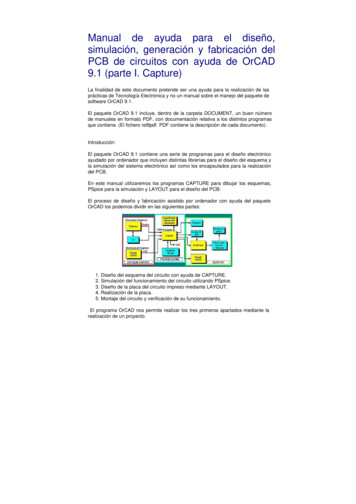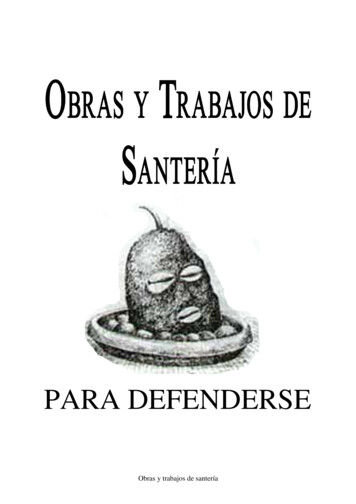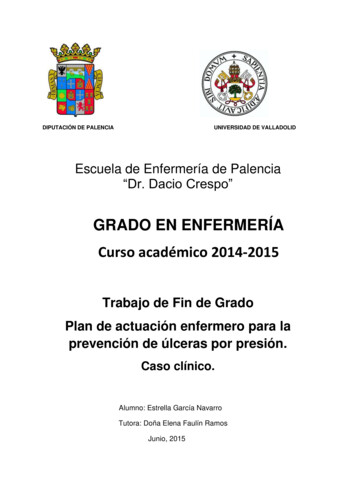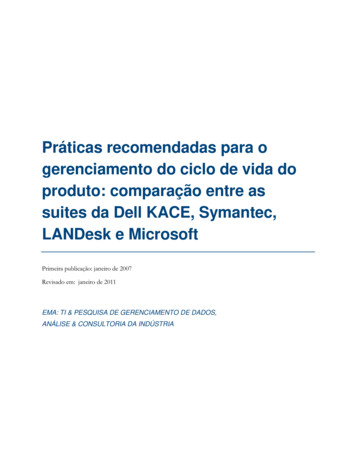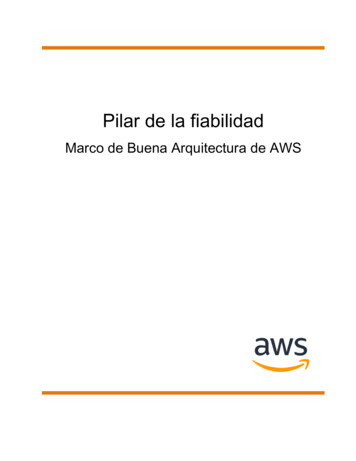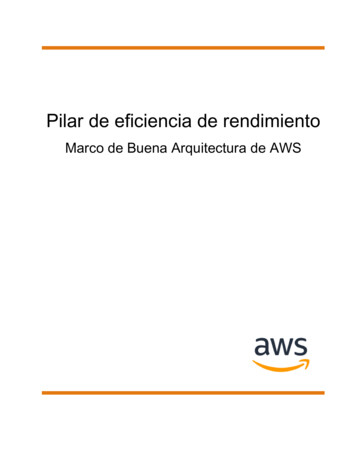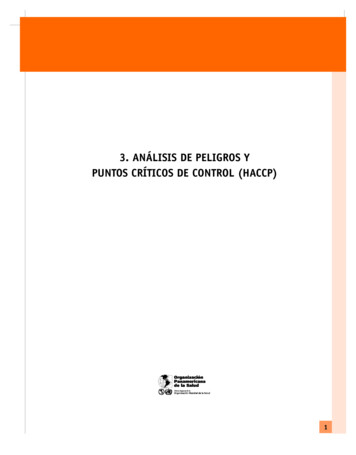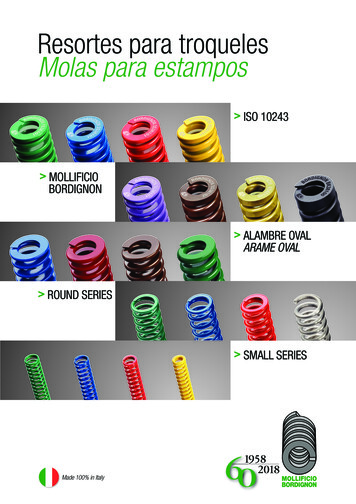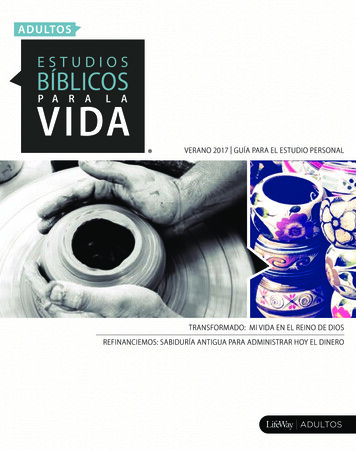
Transcription
PRÁCTICAS RECOMENDADAS PARA LA OPERACIÓN DEPOLIPASTOS DE CADENA DE PALANCA MANUALDebido a que el fabricante no tiene control directo sobre el polipasto y su operación, es responsabilidad del usuario y del personal operador elmanejo seguro del equipo. Se ha seguido la norma ANSI/ASMEB30.16 como guía en la preparación de esta lista de LO QUE SE DEBE y LOQUE NO SE DEBE HACER. Pida un ejemplar a su supervisor. Cada aviso está identificado según la norma ANSI/NEMAZ535.4, ya sea con elsigno de PRECAUCIÓN o ADVERTENCIA, para indicar el grado de seriedad.ADVERTENCIAPRECAUCIÓNEl uso inadecuado de un polipasto puede crear una situaciónpotencialmente peligrosa, que de no evitarse, puede resultar enmuerte o graves lesiones. Para evitar dicha situación, el operadordebe:La operación inadecuada de un polipasto puede crear una situaciónpotencialmente peligrosa, que de no evitarse, puede resultar endaños menores o moderados. Para evitar tales peligros el .16.17.18.19.20.21.22.23.24.25.26.27.28.29.NO operar el polipasto si está funcionando incorrectamente o demanera inusual.NO operar el polipasto antes de haber leído y entendidocompletamente las instrucciones o manuales de operación ymantenimiento del fabricante.NO operar el polipasto si ha sido modificado sin la aprobación delfabricante o sin la certificación de conformidad con las normas de laOSHA.NO levantar ni tirar más de la carga estipulada para el polipasto.NO usar polipastos dañados o que no estén trabajandoapropiadamente.NO usar polipastos con la cadena de carga torcida, enredada, dañadao gastada.NO operar el polipasto con ninguna extensión de palanca (barra dealargamiento)NO intentar liberar el polipasto de la cadena cuando se esté aplicandouna carga.NO usar el polipasto para levantar, apoyar o transportar personas.NO levantar cargas sobre personas y asegurarse de que éstaspermanezcan alejadas de la carga.NO intentar estirar la cadena ni repararla si está dañada.Proteger la cadena de carga del polipasto de chispas de soldadura yotras materias contaminantes.NO operar el polipasto cuando su movimiento esté restringido y nopueda formar una línea recta de gancho a gancho en dirección de lacarga.NO usar la cadena como eslinga ni enrollarla alrededor de la carga.NO aplicar la carga a la punta del gancho o al seguro del mismo.NO aplicar la carga a menos que la cadena esté adecuadamentesentada en la(s) rueda(s) o catalina(s).NO aplicar la carga si el cojinete impide repartir equitativamente lacarga entre todas las cadenas de soporte.NO operar más allá del límite de viaje de la cadena de carga.NO desatienda la carga soportada por el polipasto a menos que tomeprecauciones específicas.NO permitir el uso de la cadena o del gancho para hacer contactoeléctrico o tierra para operaciones de soldadura.NO permitir que la cadena o el gancho sean tocados por un electrodode soldadura energizado.NO retirar ni tapar los rótulos de advertencia del polipasto.NO operar el polipasto si no ha sido asegurado a un soporteadecuado.NO operar un polipasto a menos que la(s) eslinga(s) de carga u otrosaccesorios sean del debido tamaño y estén sujetos al gancho.NO levantar cargas que no estén balanceadas o cuya sujeción no seasegura, y tensar cuidadosamente la holguraNO operar el polipasto a menos que todas las personas estén ypermanezcan fuera del área de la carga soportada.Notificar todo mal funcionamiento o desempeño anormal delpolipasto, después de que haya sido desconectado para su reparación.NO operar el polipasto si le faltan los rótulos o calcomanías deseguridad o estén ilegibles.Estar familiarizados con los controles de mando, procedimientos .Mantener una postura firme o asegurarse de alguna forma cuando opereel polipasto.Verificar el funcionamiento del freno, tensionando el polipasto, antesde cada operación de levantamiento o arrastre.Usar los seguros de los ganchos. Los seguros son para retener eslingas,cadenas, etc. solamente en condiciones de holgura.Asegurarse de que los seguros de los ganchos estén cerrados sinsoportar ninguna carga.Asegurarse de que la carga esté libre para moverse y que libre todos losobstáculos.Evitar columpiar la carga o el gancho.Evitar el “movimiento de retroceso” de la palanca sosteniéndolafirmemente, hasta que se complete el recorrido de la operación y lapalanca esté en posición de reposo.Inspeccionar el polipasto regularmente, sustituir partes dañadas ogastadas y mantener registros apropiados de mantenimiento.Usar las piezas de repuesto recomendadas por el fabricante cuando serepare la unidad.Lubricar la cadena del polipasto de acuerdo a las recomendaciones delfabricante.NO usar el dispositivo de limitación de carga o advertencia para medirla carga.NO operar el polipasto de ninguna forma que no sea la manual.NO permitir que más de un operador tire de la palanca al mismotiempo. Más de un operador podría causar sobrecarga.NO permitir que la atención se le desvíe de la operación del polipasto.NO permitir que el polipasto, debido al manejo incorrecto del mismo,se golpee contra otros polipastos, estructuras u objetos.NO ajustar ni reparar el polipasto a menos que lo haga personalcalificado.AVISOEn ninguna circunstancia, el Hoist Manufacturers Institute (HMI) asumeninguna responsabilidad por el uso de estas recomendaciones que sonvoluntarias y tampoco las garantiza. Las recomendaciones no tienenprecedencia sobre normas y reglamentos del plan de seguridad existente, nisobre los reglamentos de la OSHA o instrucciones del fabricante. Se suponeque es la intención del usuario liberar y proteger al HMI de cualquierresponsabilidad, contractual o extracontractual, y de cualquier tipo.
What is HMI?What is HMI?The Hoist Manufacturer’s Institute (HMI), an affiliate of MaterialHandling Industry, is a trade association of manufacturers of overheadhandling hoists. HMI members are the Industry’s leading suppliers ofhoisting equipment including hand chain hoists, ratchet lever hoists,trolleys, air chain hoists, air wire rope hoists, electric chain hoists, andelectric wire rope hoists. HMI operates through committees withprograms and policies reviewed and adopted by the membership withrepresentation from each member company. Its many activitiesinclude an active engineering committee. HMI is represented on anumber of standards developing committees and actively supports thedevelopment and certification of safety standards by the ANSIconsensus method.HMI MissionOur Mission is to deliver exceptional value to our members, channelpartners, consumers, end-users and industry associates.HMI achieves this through: Educational MaterialsMarketing InformationStandards DevelopmentMember Professional DevelopmentHMI VisionHMI is recognized as the leading authority and the principal resourcein the hoist industry. HMI is recognized as the leading advocate forthe safe application and operation of hoisting equipment and relatedproducts. HMI conducts business professionally with a spirit ofenthusiasm, cooperation, honesty and integrity. HMI Members arerecognized as: The leaders in the marketplace.Delivering superior value in their products and servicesProviding products and services that are safe and productive.Proving high value solutions through knowledgeable and expertchannel partners.Providing an environment in which our customers can confidentlypurchase and derive superior value from our products.CMAA – 8720 Red Oak Blvd., Suite 201 – Charlotte, NC 28217 – 704-676-1190 – Fax 704-676-1199 – www.mhia.org/hmi
Value StatementWhat is the value of membership in the Hoist Manufacturers Institute(HMI)?1. Market Intelligence Information:a.b.c.d.Unit and volume statistics programMarket forecasts and economic indicator monitoringIndustry forecastsGeographic product distribution and planning data,workshopse. Channel partner planning workshopsf. Trend monitoringg. Planning and forecasting tools, workshops2. Members Professional Developmenta.b.c.d.Leadership developmentMulti-topic educational seriesNetworking throughout the industryPeer to peer interaction3. Promotion of the Safe Use of our Productsa.b.c.d.e.f.Development of product standardsDo’s and Don’ts for product usageDevelopment of maintenance and service inspection manualsDevelopment of proper hoist usage documentsAlliance program with OSHA to promote safetyTip and Fact Sheets for OSHA distribution4. HMI Members are recognized as the Market’s Leaders; HMIMembers: Are Speakers and Education Subject ExpertsProvide Engineering Specification and Standards InputPublish a Compendium of Product Standards5. Increased Exposure to Customers Web-based Case Studies provide Market Solutions toUsersMHIA Website channels customers to HMI membersHMI Certified Program Increases Product ValueParticipation in HMI can increase your business levels, increase yourexposure in the marketplace, develop your employees, help yourcorporate decision-making, increase safe usage of your products, andposition you as one of the leaders in the hoist industry.CMAA – 8720 Red Oak Blvd., Suite 201 – Charlotte, NC 28217 – 704-676-1190 – Fax 704-676-1199 – www.mhia.org/hmi
For information regarding membership, standards, specifications, market research initiatives,industry statistics, literature or publications. HMI Managing Director Hal Vandiver: hvandiver@mhia.orgExecutive Assistant Cathy Moose: cmoose@mhia.orgHMI8720 Red Oak Blvd., Suite 201Charlotte, NC 28217-3992Phone: 800-345-1815 / 704-676-1190URL: www.mhia.org/hmiFax: 704-676-1199Call the Material Handling Institute Literature Department at 800-345-1815 or 704-676-1190 or go towww.mhia.org/hmi , “Publications and Resources”, to order the following HMI publications:#10166 - Comparison of Hoist Duty Service ClassificationsCOMPARISON OF HOIST DUTY SERVICE CLASSIFICATIONS, AS DESCRIBED IN UNITED STATES ANDEUROPEAN WIRE ROPE HOIST SPECIFICATIONS - Hoist Manufacturers may often not be aware of exacthoist applications, and further the nature of the liability laws in the United States, it has customarily been thepractice of the United States hoist manufacturers to design and build products with long, although unspecified,service lives. This may be contrasted with the practices of many European manufacturers who build andprovide products for specific applications and state mandated removal from service dates for overhaul orreplacement. The Hoist Manufacturers Institute (HMI) has created the 'Comparison of Hoist Duty ServiceClassifications, as described in United States and European Wire Rope Hoist Specifications', to offer thisinformation to those considering purchase and use of overhead handling hoists (excluding Electric ChainHoists). FREE DOWNLOAD.#10194 - HMI Consensus of the National Electrical CodeThe 1999 National Electrical Code has a number of paragraphs in it affecting electric chain and wire ropehoists. Some of these paragraphs are subject to carrying interpretations. Therefore, acting through theelectrical engineering subcommittee of the HMI engineering committee, and with the approval of the HMIBoard of Directors, the Hoist Manufacturers Institute has developed and authorized the publication of theconsensus contained within the pamphlet. It is hoped that the HMI Consensus will be mutually helpful to users,manufacturers and sellers of electric chain and wire rope hoists. FREE DOWNLOAD.#10024 - Hoist Inspection and Maintenance Personnel ManualThis manual has been prepared by HMI and it's Engineering Committee to provide information andsuggestions for Hoist Inspection and Maintenance Personnel in their inspection and maintenance of overheadhoists. A thorough understanding of the information provided in this manual should provide a betterunderstanding of safe inspection, maintenance, and operation and afford a greater margin of safety for peopleand machinery on the plant floor.FREE DOWNLOAD.#10023 – Hoist Operators ManualThis 54-page booklet lists qualifications required to be a hoist operator, as well as "shall and shall nots." Safetyis stressed by describing the best way to operate a hoist. The safety suggestions are intended to supplementcompany safety practices and hoist manufacturers' instructions. FREE DOWNLOAD.CMAA – 8720 Red Oak Blvd., Suite 201 – Charlotte, NC 28217 – 704-676-1190 – Fax 704-676-1199 – www.mhia.org/hmi
#10074 - Manually Lever Operated Hoist Inspection & MaintenanceThis manual has been prepared by HMI and its Engineering Committee with the sole intent of offeringinformation and suggestions to parties engaged with Manually Lever Operated Hoist Inspection andMaintenance Personnel in their inspection and maintenance of manually lever operated hoist. A thorough studyof the following information should provide a better understanding of safe operation and afford a greater marginof safety for people and machinery on the plant floor. FREE DOWNLOAD.#10075 - Manually Lever Operated Hoist Operators ManualThis booklet lists qualifications required to be a Manually Lever Operated Hoist Operator, as well as "shall andshall nots". Safety is stressed by describing the best way to operate a manually lever operated hoist. Theoperator must consider and anticipate the motions, actions, and loads that will occur as a result of operatingthe hoist.#10198 - Overhead Material Handling Market History and ForecastThis 59-page presentation has been developed for professional researchers interested in learning more aboutthe statistical characteristics of the overhead material handling market for planning purposes. Information ispresented in chart form to reveal information about market size and growth, product mix, domestic production,imports, exports, consumption, capacity utilization, economic indicators, market potential and a variety of otherinsights. Source data has been gathered principally from the U.S. Department of Commerce (USDOC), theU.S. International Trade Commission (USITC), the U.S. Bureau of Economic Analysis (BEA) and the U.S.Federal Reserve Board (FRB). Insights are provided by MHIA Staff and the Managing Director of CMAA, HMIand MMA, independent trade associations affiliated with the Material Handling Industry of America. (NOTE:This document will be emailed to you after you complete your order. This could take up to 24 hours - please donot order if you need it immediately. 750.00#10103 - Recommended Practices for Electric and Air Powered HoistsThe Hoist Manufacturers Institute (HMI), an association affiliated with Material Handling Industry, has producedguidelines for the operation of various types of hoists. Many of the warnings and operating practices outlined ineach publication were taken from American National (Safety) Standard ANSI B30.16 and are intended to avoidunsafe hoisting practices which might lead to personal injury or property damage. Each of the publications alsotells the reader about HMI and lists the HMI member companies. The Shall's and Shall Not's are each onepage and handy for posting on bulletin boards or in areas where hoists are used.FREE DOWNLOAD.#10191 - Recommended Practices for Electric & Air Powered Hoists(SPANISH/FRENCH) - The Hoist Manufacturers Institute (HMI), an association affiliated with Material HandlingIndustry, has produced guidelines for the operation of various types of hoists. Many of the warnings andoperating practices outlined in each publication were taken from American National (Safety) Standard ANSIB30.16 and are intended to avoid unsafe hoisting practices which might lead to personal injury or propertydamage. Each of the publications also tells the reader about HMI and lists the HMI member companies. TheShall's and Shall Not's are each one page and handy for posting on bulletin boards or in areas where hoistsare used. FREE DOWNLOAD.#10104 - Recommended Practices for Hand Chain HoistsThe Hoist Manufacturers Institute (HMI), an association affiliated with Material Handling Industry, has producedguidelines for the operation of various types of hoists. Many of the warnings and operating practices outlined ineach publication were taken from American National (Safety) Standard ANSI B30.16 and are intended to avoidunsafe hoisting practices which might lead to personal injury or property damage. Each of the publications alsotells the reader about HMI and lists the HMI member companies. The Shall's and Shall Not's are each onepage and handy for posting on bulletin boards or in areas where hoists are used. FREE DOWNLOAD.CMAA – 8720 Red Oak Blvd., Suite 201 – Charlotte, NC 28217 – 704-676-1190 – Fax 704-676-1199 – www.mhia.org/hmi
#10192 - Recommended Practices for Hand Chain Hoists(SPANISH/FRENCH) - The Hoist Manufacturers Institute (HMI), an association affiliated with Material HandlingIndustry, has produced guidelines for the operation of various types of hoists. Many of the warnings andoperating practices outlined in each publication were taken from American National (Safety) Standard ANSIB30.16 and are intended to avoid unsafe hoisting practices which might lead to personal injury or propertydamage. Each of the publications also tells the reader about HMI and lists the HMI member companies. TheShall's and Shall Not's are each one page and handy for posting on bulletin boards or in areas where hoistsare used. FREE DOWNLOAD#10105 - Recommended Practices - Manually Lever Operated Chain HoistsThe Hoist Manufacturers Institute (HMI), an association affiliated with Material Handling Industry, has producedguidelines for the operation of various types of hoists. Many of the warnings and operating practices outlined ineach publication were taken from American National (Safety) Standard ANSI B30.16 and are intended to avoidunsafe hoisting practices which might lead to personal injury or property damage. Each of the publications alsotells the reader about HMI and lists the HMI member companies. The Shall's and Shall Not's are each onepage and handy for posting on bulletin boards or in areas where hoists are used.FREE DOWNLOAD.#10193 - Recommended Practices - Manually Lever Operated Chain Hoists(SPANISH/FRENCH) - The Hoist Manufacturers Institute (HMI), an association affiliated with Material HandlingIndustry, has produced guidelines for the operation of various types of hoists. Many of the warnings andoperating practices outlined in each publication were taken from American National (Safety) Standard ANSIB30.16 and are intended to avoid unsafe hoisting practices which might lead to personal injury or propertydamage. Each of the publications also tells the reader about HMI and lists the HMI member companies. TheShall's and Shall Not's are each one page and handy for posting on bulletin boards or in areas where hoistsare used. FREE DOWNLOADCMAA – 8720 Red Oak Blvd., Suite 201 – Charlotte, NC 28217 – 704-676-1190 – Fax 704-676-1199 – www.mhia.org/hmi
Members of the Hoist Manufacturers Institute, Inc.Acco Material Handling Solutions76 Acco DriveYork, PA 17405(800) 967-7333www.accomhs.comDemag Cranes & Components Corp.29201 Aurora RoadSolon, OH 44139(440) 248-2400www.demag-us.comAce World Companies Inc.10200 Jacksboro HighwayFort Worth, TX 76135(817) 237-7700www.aceworldcompanies.comElectrolift, Inc.204 Sargeant AvenueClifton, NJ 07013(973) 471-0204www.electrolift.comChester Hoist7573 State Route 45, NorthLisbon, OH 44432(330) 424-7248www.chesterhoist.comHarrington Hoists Inc.401 West End AvenueManheim, PA 17545(800) 233-3010www.harringtonhoists.comCoffing Hoists2020 Country Club LaneWadesboro, NC 28170(800) 888-0985www.coffinghoists.comIngersoll-Rand Company1467 Route 31 SouthAnnandale, NJ 08801(908) bus McKinnon Corporation140 John James Audubon ParkwayAmherst, NY 14228(716) 689-5400www.cmworks.comJ.D. Neuhaus L.P.9 Loveton CircleSparks, MD 21152(410) 472-0500www.jdneuhaus.comR&M Materials Handling, Inc.4501 Gateway BoulevardSpringfield, OH 45502(937) 328-5100www.rmhoist.comSTAHL CraneSystems, Inc.6420 Dorchester RoadCharleston, SC 29418(843) 767-1951www.stahlus.comYale Hoists240 Pennsylvania AvenueSalem, MI 44460(231) 733-0821www.yalehoists.netHoist Manufacturers Institute, Inc., 8720 Red Oak Boulevard, Suite 201, Charlotte, NC 28217-3992Ph.: (704) 676-1190, Fax: (704) 676-1199, www.mhia.org/hmi6/11
9. NO usar el polipasto para levantar, apoyar o transportar personas. 10. NO levantar cargas sobre personas y asegurarse de que éstas permanezcan alejadas de la carga. 11. NO intentar estirar la cadena ni repararla si está dañada. 12. Proteger la cadena de carga del polipasto de chispas de soldadura y otras materias contaminantes. 13.
